Pre- and Post-COVID: Trends from Online Job Ads
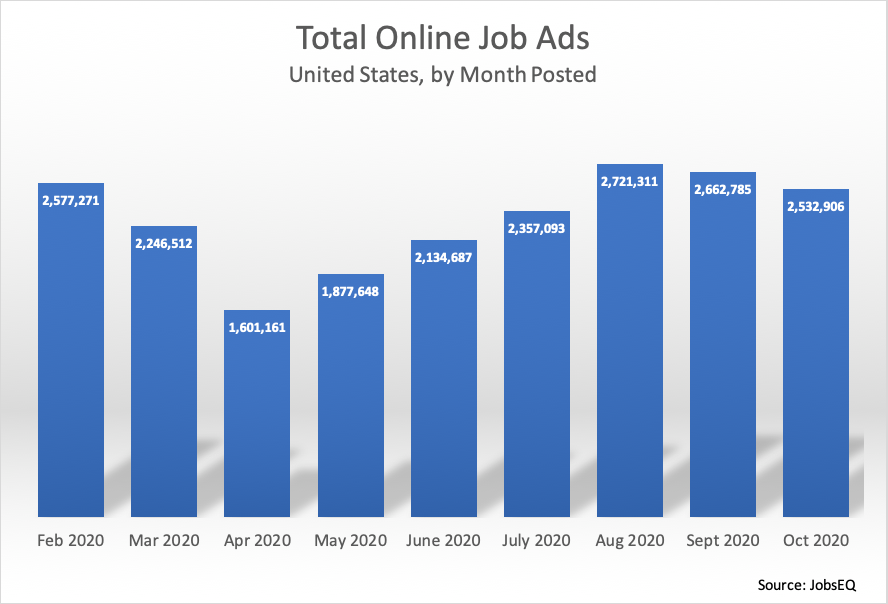
By Greg Chmura |
How has the labor market shifted in the post-COVID world, that is, since the appearance of COVID?[1] Which occupations have been impacted? Which skillsets and certifications have seen increases or decreases in demand? In this blog we compare new job ads from the six-month period of May-through-October 2020 to the same set of months of 2019 for insights into these questions.
The Overall Market

First, looking at the big picture, we see that new job ads plummeted as the economy shut down due to COVID-19. The number of new job ads in February 2020 dropped 38% to a trough in April. Volume slowly climbed back and didn’t recover fully until August. Ads in September and October were lower than August, but this is not an unusual pattern for that time of year.
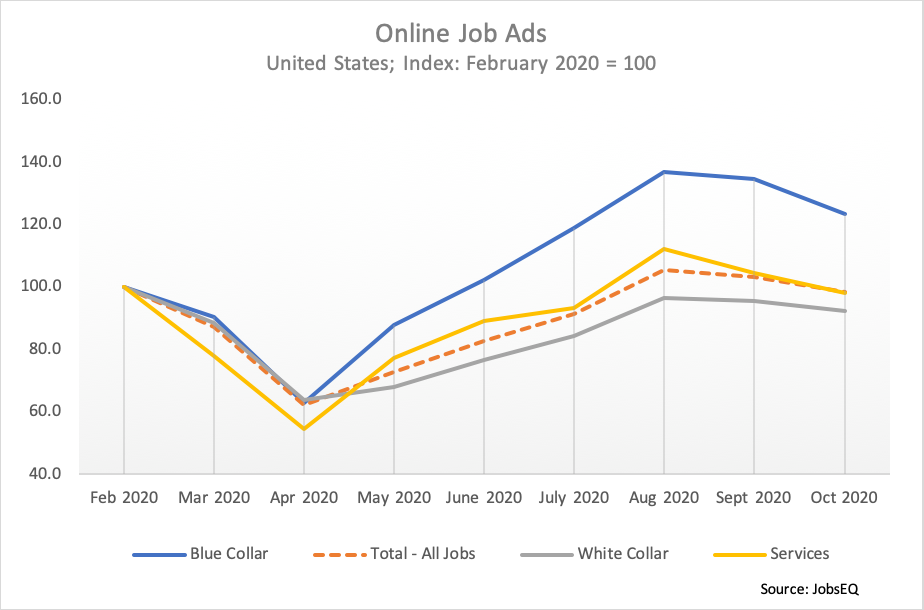
Another significant trend to note is the variation in recovery among broad occupation groups. Blue collar jobs (which include transportation occupations) rebounded quickly and have well surpassed pre-COVID levels. Services jobs were hit hardest in the first months of the pandemic shutdown, but then rebounded at an above-average pace. White-collar jobs have had the slowest recovery in new job ads, but as we noted previously, a decline in job separations (including quits, layoffs, and retirements) in related industries likely played a role in fewer job openings for this group. Fewer workers overall have been quitting their jobs in 2020. Per BLS JOLTS data, the quits rate averaged 2.12% from March through August of 2020 compared to 2.75% in the same months of 2019.
Occupation Impacts
Comparing the post-COVID environment (May through October 2020) to the same period in the prior year (May through October 2019), we can see a number of interesting trends. In this section we highlight occupation impacts. In the next section we’ll dive further into the data for skill impacts.
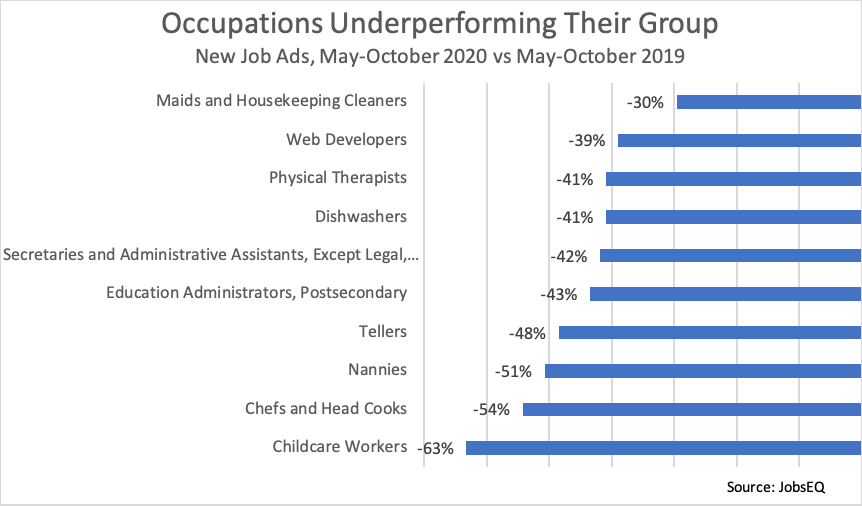
Comparing the post-COVID period to pre-COVID, the occupations shown above all declined in job postings and fared worse compared to others within their major occupation group (2-digit SOC level). For example, healthcare occupations have been up in the 2020 post-COVID environment, but physical therapists have seen significant drops in job demand.[2] New job ads for computer occupations dropped as a group, but demand for web developers dropped even more. Demand for childcare workers and nannies plummeted in 2020. Chefs, head cooks, and dishwashers were hard hit among food-service jobs. Postsecondary education administrators, tellers, secretaries, and maids also were disproportionately impacted and saw many fewer new job ads in the post-COVID economy.
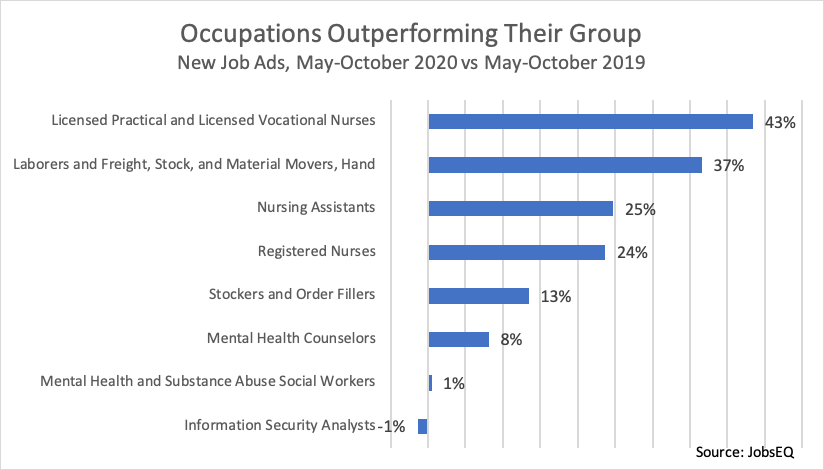
On the positive side, some occupations have exceeded their peers. Though healthcare jobs overall were up post-COVID, LPNs, RNs, and nursing assistants saw especially strong demand. Transportation workers were up overall too, with especially increased demand for stockers and order fillers as well as laborers, and freight, stock, and material movers, hand. Community and social service job ads were down overall, but demand for mental health and substance abuse workers expanded as adverse mental health conditions increased in the United States due to COVID.[3] Among computer occupations, information security analysts fared much better than average, though the number of job ads for that occupation was slightly lower post-COVID compared to the same period in 2019.
Skill Impacts
In this section we look at skills within occupations, that is, cases where there has there been an increase in demand for certain skills within specific occupations. As above, we are comparing job ad requirements from May through October 2020 to the same months in 2019.
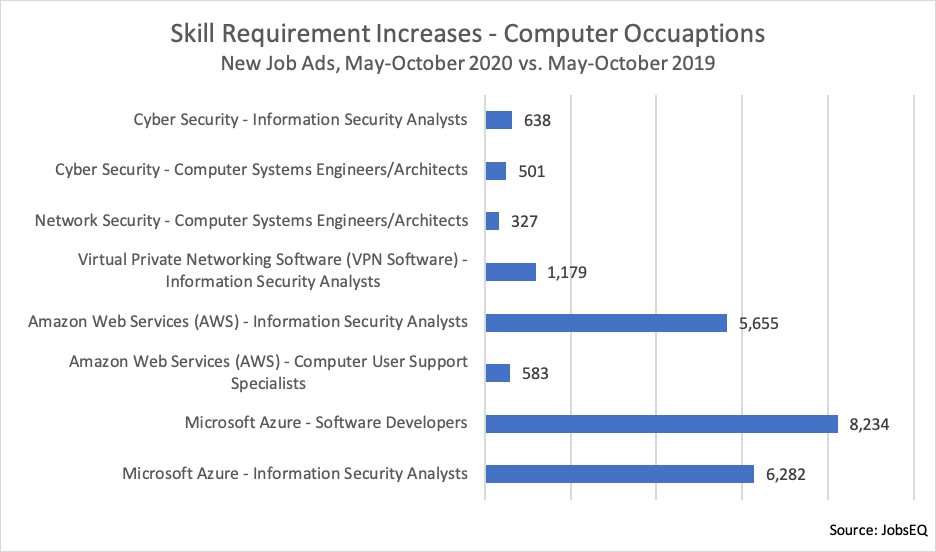
As more individuals needed to work from home due to the pandemic, there has been an increased need for secure networks. Skills with cyber security and network security have been more often found as requirements among information security analysts and computer systems engineers/architects. Skill with VPN Software also has increased in demand as workers use that means to connect to workplace computer networks. Cloud computing has also seen an increase among a variety of computer occupations—several of which are shown above—specifically in Amazon Web Services and Microsoft Azure.
Along with these skills increases, there has been growth in demand for certifications related to these skills. There has been an increase in ad requirements for the Certified Cloud Security Professional (CCSP) certification among information security analysts. Among network and computer systems administrators there has been growth in demand for the CompTIA Security+ CE (Continuing Education) cert as well as the CompTIA Advanced Security Practitioner (CASP) certification.
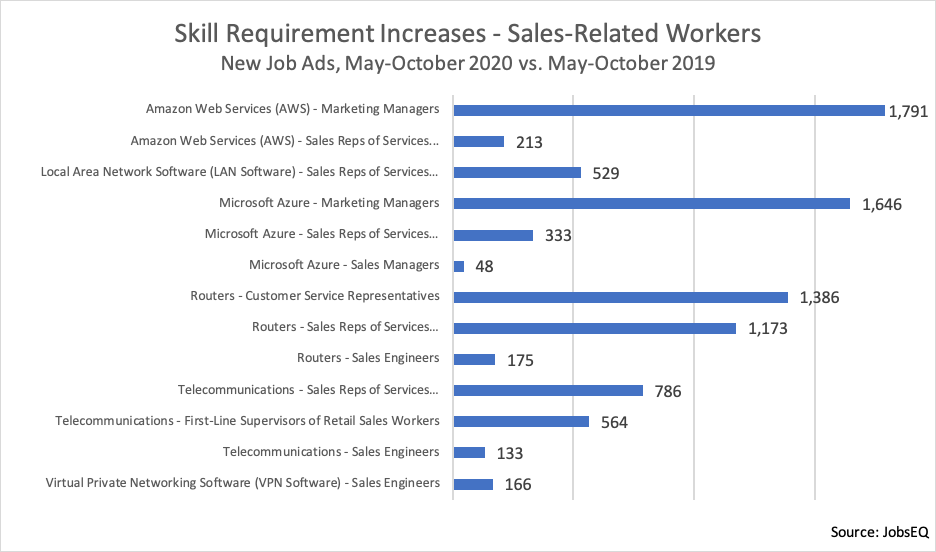
Sales and related workers in marketing and support have also seen changes in requirements due to the technological changes around increases in remote work. Job ads for sales representatives have increasingly referenced cloud computing services, LAN software, routers, and telecommunications. Likewise, marketing managers, sales managers, sales engineers, and customer service reps have seen an increase in requirements to having skills or knowledge in these areas.
About the Data
All job postings data above are derived from JobsEQ, the Real-Time Intelligence online job ad data set, pulled from over 40,000 websites and updated daily. Historical volume is revised as additional data are made available and processed. Each month of ads is defined as new online ads that first appeared in that month. All ad counts represent deduplicated figures. The relationship between ad counts and actual hires is described here.
Many extraneous factors can affect short-term volume of online job postings. Thus, while the changes noted above should be watched over time to confirm the impacts, such a short-term snapshot can offer an early indication of labor market shifts, especially valuable in this time of unprecedented economic disruption.
[1] To be clear, “post-COVID” in this blog refers to the period after the appearance of COVID. We are not meaning to imply that COVID-19 is not still active.
[2] For more on the impact of COVID on the physical therapy profession, see: https://www.apta.org/contentassets/15ad5dc898a14d02b8257ab1cdb67f46/impact-of-covid-19-on-physical-therapy-profession.pdf
[3] https://www.cdc.gov/mmwr/volumes/69/wr/mm6932a1.htm
Subscribe to the Weekly Economic Update
Subscribe to the Weekly Economic Update and get news delivered straight to your inbox.








